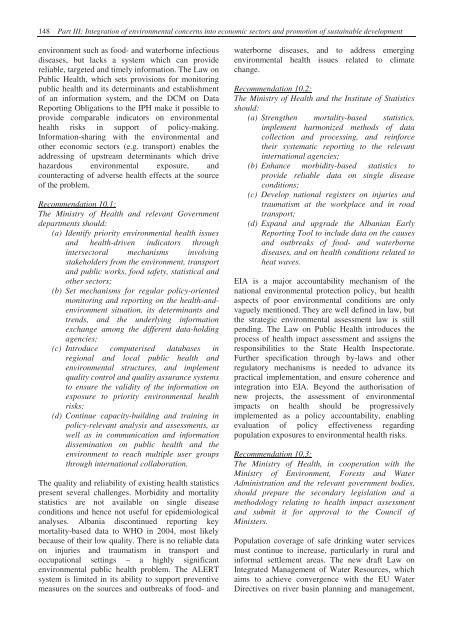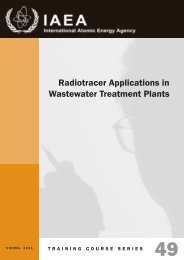Second Environmental Performance Review of Albania
Second Environmental Performance Review of Albania
Second Environmental Performance Review of Albania
You also want an ePaper? Increase the reach of your titles
YUMPU automatically turns print PDFs into web optimized ePapers that Google loves.
148 Part III: Integration <strong>of</strong> environmental concerns into economic sectors and promotion <strong>of</strong> sustainable developmentenvironment such as food- and waterborne infectiousdiseases, but lacks a system which can providereliable, targeted and timely information. The Law onPublic Health, which sets provisions for monitoringpublic health and its determinants and establishment<strong>of</strong> an information system, and the DCM on DataReporting Obligations to the IPH make it possible toprovide comparable indicators on environmentalhealth risks in support <strong>of</strong> policy-making.Information-sharing with the environmental andother economic sectors (e.g. transport) enables theaddressing <strong>of</strong> upstream determinants which drivehazardous environmental exposure, andcounteracting <strong>of</strong> adverse health effects at the source<strong>of</strong> the problem.Recommendation 10.1:The Ministry <strong>of</strong> Health and relevant Governmentdepartments should:(a) Identify priority environmental health issuesand health-driven indicators throughintersectoral mechanisms involvingstakeholders from the environment, transportand public works, food safety, statistical andother sectors;(b) Set mechanisms for regular policy-orientedmonitoring and reporting on the health-andenvironmentsituation, its determinants andtrends, and the underlying informationexchange among the different data-holdingagencies;(c) Introduce computerised databases inregional and local public health andenvironmental structures, and implementquality control and quality assurance systemsto ensure the validity <strong>of</strong> the information onexposure to priority environmental healthrisks;(d) Continue capacity-building and training inpolicy-relevant analysis and assessments, aswell as in communication and informationdissemination on public health and theenvironment to reach multiple user groupsthrough international collaboration.The quality and reliability <strong>of</strong> existing health statisticspresent several challenges. Morbidity and mortalitystatistics are not available on single diseaseconditions and hence not useful for epidemiologicalanalyses. <strong>Albania</strong> discontinued reporting keymortality-based data to WHO in 2004, most likelybecause <strong>of</strong> their low quality. There is no reliable dataon injuries and traumatism in transport andoccupational settings – a highly significantenvironmental public health problem. The ALERTsystem is limited in its ability to support preventivemeasures on the sources and outbreaks <strong>of</strong> food- andwaterborne diseases, and to address emergingenvironmental health issues related to climatechange.Recommendation 10.2:The Ministry <strong>of</strong> Health and the Institute <strong>of</strong> Statisticsshould:(a) Strengthen mortality-based statistics,implement harmonized methods <strong>of</strong> datacollection and processing, and reinforcetheir systematic reporting to the relevantinternational agencies;(b) Enhance morbidity-based statistics toprovide reliable data on single diseaseconditions;(c) Develop national registers on injuries andtraumatism at the workplace and in roadtransport;(d) Expand and upgrade the <strong>Albania</strong>n EarlyReporting Tool to include data on the causesand outbreaks <strong>of</strong> food- and waterbornediseases, and on health conditions related toheat waves.EIA is a major accountability mechanism <strong>of</strong> thenational environmental protection policy, but healthaspects <strong>of</strong> poor environmental conditions are onlyvaguely mentioned. They are well defined in law, butthe strategic environmental assessment law is stillpending. The Law on Public Health introduces theprocess <strong>of</strong> health impact assessment and assigns theresponsibilities to the State Health Inspectorate.Further specification through by-laws and otherregulatory mechanisms is needed to advance itspractical implementation, and ensure coherence andintegration into EIA. Beyond the authorisation <strong>of</strong>new projects, the assessment <strong>of</strong> environmentalimpacts on health should be progressivelyimplemented as a policy accountability, enablingevaluation <strong>of</strong> policy effectiveness regardingpopulation exposures to environmental health risks.Recommendation 10.3:The Ministry <strong>of</strong> Health, in cooperation with theMinistry <strong>of</strong> Environment, Forests and WaterAdministration and the relevant government bodies,should prepare the secondary legislation and amethodology relating to health impact assessmentand submit it for approval to the Council <strong>of</strong>Ministers.Population coverage <strong>of</strong> safe drinking water servicesmust continue to increase, particularly in rural andinformal settlement areas. The new draft Law onIntegrated Management <strong>of</strong> Water Resources, whichaims to achieve convergence with the EU WaterDirectives on river basin planning and management,
















